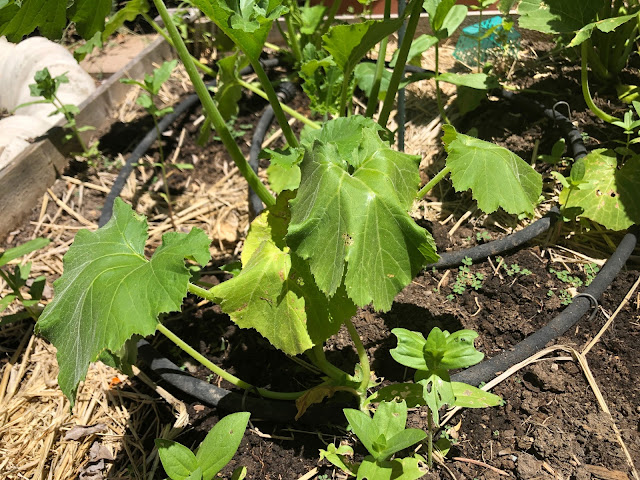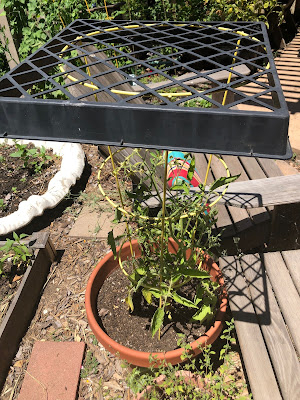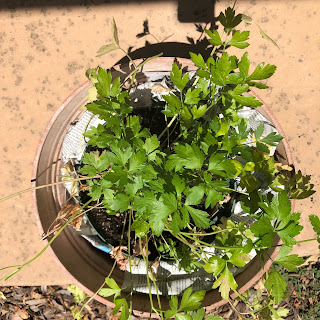 |
|
This wilting squash plant doesn't need a rescue -- the wilting is its natural survival mode in heat.
But other plants might need some first aid in a heat wave. (Photos: Kathy Morrison)
|
It happens to all of us who garden in the heat belt of the Central Valley. The blazing sun finds a plant before you do, and it’s already in trouble when you do find it.
Help! Can it be rescued? Let’s assume so. Here are some ways to figure out the best rescue:
In-ground plants
1. Is it wilting? That's probably how you noticed it was in trouble. First, check the moisture level around the plant. Dig down about 6 inches with a probe or small trowel (avoid the roots if possible) and see if the soil is dry.
If there's dry soil below about the top inch or so, water the plant immediately and adequately so that the little feeder roots can soak up the water. Keep an eye on the plant. If it's pretty new to that spot, you should also give it some shade until it recovers.
 |
|
A plant flat on top of a tomato cage is a quick
shade solution.
|
A short tomato cage topped with burlap or even one of those square plastic plant flats is a good makeshift shade structure. Depending on the size of plant, an open umbrella or a piece of shade cloth tied to two stakes also could work. Also, avoid draping fabric on the plant itself; that just adds to its stress.
Important: Don't feed a wilted plant until it fully recovers. There are some liquid concentrate booster products, however, that can be added to that first thorough watering; SuperThrive is one I like for recovery efforts.
Wilting plants with adequately moist soil are just using their natural heat defenses and should perk up again as temperatures drop. Tomatoes and squash plants do this routinely on hot afternoons (see photo at top). Don't water the plant; just keep an eye on it. If it's still wilting in the morning, then water.
If the plant is wilting but the soil is quite wet, you have a serious irrigation problem. Your plant could be drowning. Investigate where all the water is coming from and shut it off asap. You might also dig a tiny trench -- just drag the top of your trowel along the ground -- to pull some of that moisture away from the plant. The plant should recover, as long as the soil is allowed to dry, but keep an eye on it for fungus development. And fix that irrigation source pronto.
2. Is it sunburned? Oh, boy, been there. Tomato leaves in particular can get scorched in heat, but other vegetables do too. If the plant's not otherwise wilting, just give it some shade while the temps are high. (See shade suggestions above.) Don't cut off any burned leaves at first, because they'll protect the plant for a bit. Once daytime temps moderate, you can cut off the dead leaves to make room for new growth.
If the burned plant is a shrub or tree, you might consider whether it's planted in the right spot. Not every "full sun" plant can cope with our heat. Did there used to be more shade in that spot, as from a tree that's since been removed? Watch where the light falls during the course of the day. If it's getting full-bore afternoon sun, the scorched plant could be a candidate for a move this fall when transplanting is easier on you and the plant. Meanwhile, give it some shade.
Container plants
Plants in pots are more susceptible to heat stress because their roots are above ground and vulnerable on all sides. In a prolonged heat wave, they might require watering twice daily.
For a stressed plant, moving it to a shadier area is the first-aid remedy. Then check these situations:
1. Is the soil dried out? Water it first, and watch how it drains. Your plant's roots may have shrunk from the sides of the pot, and any water is traveling straight down the sides and out. Try to loosen the soil a bit, then put the entire pot in a bucket of water to soak until all the air bubbles are gone. Then remove the container from the bucket and keep the plant in a shaded spot to recover.
 |
A larger pot and crumpled newspaper provide insulation
for this potted parsley plant. Some shade would also help. |
2. Is the pot too small? The plant may be root-bound, which also causes frequent wilting. Transplant it as soon as possible to a larger container. Meanwhile, water it well and keep it in some shade. You can also temporarily set the pot, plant and all, inside a larger pot and fill the gap with straw or crumpled paper for insulation.
3. Was it recently transplanted? Move it out of the intense sun and baby it some more until new growth appears. You might have to prune it back if it's a large plant that's still adjusting to its new pot.
4. Is it cooked? Unglazed pottery containers and black plastic pots are cheap but are the worst for potted plants in our summers: The roots do get baked. Assuming you already tried the rescues above for a plant in one of these pots and it survived, consider moving it to something else that doesn't get so hot. Or try the pot-inside-a-pot insulation trick. Unglazed pottery also can be buried, halfway or all the way, in the ground as a temporary or even permanent solution to its rapid evaporation.
5. Is it lonely? Container plants do better in heat when several pots are grouped together; they act as mutual insulation. But try the other remedies first.



